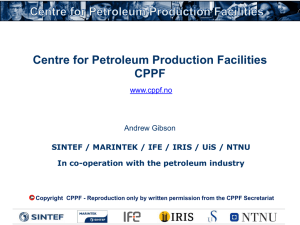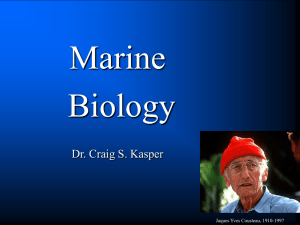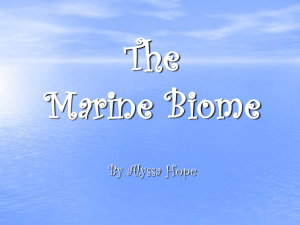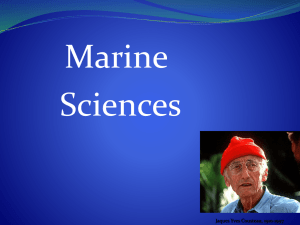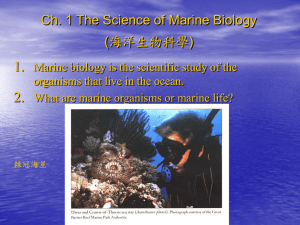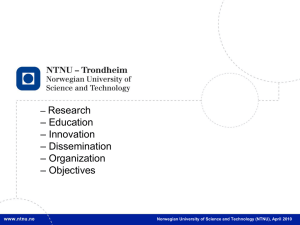The Marine Structures Laboratory
advertisement
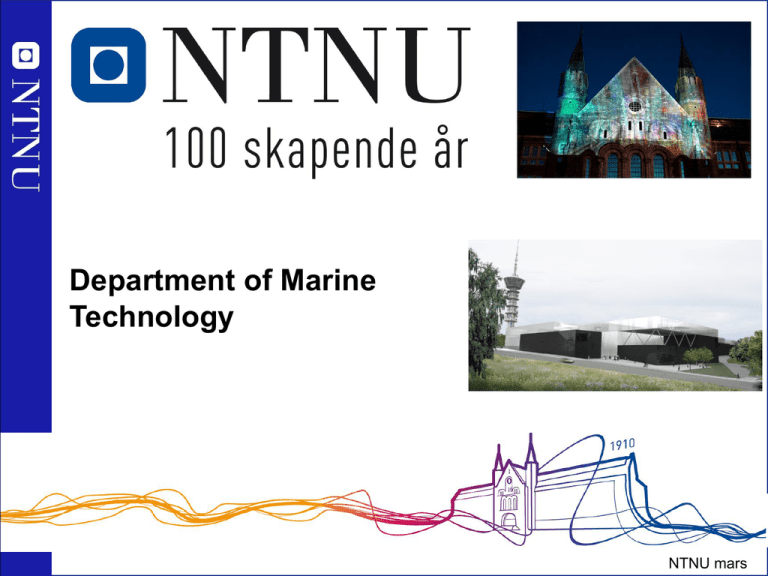
Department of Marine Technology Norges teknisk-naturvitenskapelige universitet 1 NTNU mars Welcome to NTNU in Trondheim 2 NTNU’s six Strategic Research Areas Energy and petroleum – resources and environment – because energy use has to be sustainable and efficient Medical Technology – because health is one of our greatest challenges Materials Science – because materials are the basis for new technology Marine and maritime research – because the ocean offers large quantities of unused resources and unexploited opportunities Information and communication technology – because man has to communicate Globalisation – because the world is becoming a global village Budget/resources: Annual strategic funding; ca € 300,000, ca 3 recruitment positions A main instrument for international cooperation 3 Marine Technology Centre in brief NTNU Department of Marine Technology and MARINTEK are co-located at the centre. • Graduates 80-100 MSc and 15-20 PhDs every year. • Currently 100 PhD’s in progress • The Centre of Excellence for Ships and Ocean Structures (CeSOS) is an integral part of the centre. • MARINTEK is a research institute within SINTEF (~200 employees). 4 Ship Model Tank (1939) Ocean Laboratory (1981) Construction & Energy Laboratories; Education Centre (1979) Study program marine technology Main areas • • Marine structures – Marine structures – Marine hydro dynamic – Marine cybernetic Marine systems – Marine design and logistic – Marine operations – Marine machinery – Fishery and aquaculture Study programs: • • • • • • 5 Master in marine technology (5year) (105 stud) Master in marine technology (2year) (15 stud) MSc in Marine Technology (2-year) (20 stud) N5T MSc in Maritime Engineering (2-årig) NTNU/DTU/KTH,Chalmers, Aalto (~5 stud) Cooperation with HiÅ and HiB Offshore Oil and Gas 6 Ship Technology 7 Fish Farming (Aquaculture) 8 Arctic operations 9 Renewable energy • Offshore Wind • Wave • Tidal 10 International research cooperation TU Delft KAIST Korea Nanyang Technological University 11 Utvekslingsstudenter UTGÅENDE 2012/13 (foreløpig) 16 Antall ut: 52 14 12 Antall i 4. klasse 2012/13 (5-årig program) : 100 (2-årig program) : 30 10 8 6 4 +TU Delft: ~15-20 2 0 USA 12 CanadaAustraliaTysklandSkottland Korea Singapore Brasil Portugal Laboratories • • • • • • • 13 Towing tank (230 m) Ocean laboratory (50x80x10 m) Student towing tank Cavitation loop Structural laboratory Machinery laboratory Marine Cybernetics laboratory The Ship Towing tank 14 The Ocean Laboratory 15 The Marine Structures Laboratory 16 Research Vessel: ”Gunnerus” 17 Applied Underwater Robotics Laboratory AURlab “The largest laboratory in the world” 18 Close collaboration with: • Maritime Industry • National Research and Education • International partners • Joint strategic research programmes NTNU-personnel working on SINTEF projects SINTEF employees teach at NTNU • Joint use of laboratories and instruments www.ntnu.no 19 20 Presentation at UTC Press Briefing, June 9th Ålesund 20 RFAKTA &D CESOS – Ships and Ocean Structures Design and operation of the future’s ships and ocean structures: • Marine hydrodynamics • Structural mechanics • Automatic control 6 key persons, 11 postdocs, 32 PhDs in progress (2008). A total of 40 research man-years, including visiting professors and associated personnel. Co-funded by NTNU and the Research Council of Norway 21 Oil and gas operations in deep water challenge mooring systems and risers. Scope - Relevance Renewable energy Infrastructure Seafood production Transport Principal Research Areas Ships Ocean Structures Structural Mechanics Integration of Disciplines Hydro- Automatic dynamics Control Research Challenges 22 Oil and gas production Theory Experiments/ full-scale obs. «The winner takes it all…» • SFF: 10 år, budsjett NOK 300-600 millioner • SFI/FME: 8 år, budsjett NOK 200-400 millioner • Kompetanseprosjekter (KMB): 5 år, budsjett NOK 10-20 millioner • Forskerprosjekter: 3-5 år, budsjett NOK 4-10 millioner 23 C-AMOS Proposal Multidisciplinary Research Areas & Methods Hydrodynamics and Structural Mechanics Guidance, Navigation and Control Experiments C-AMOS Interdisciplinary Research Areas & Challenges Centre for Autonomous Marine Operations and Systems Greener Operations Renewable Energy 24 Monitoring & Inspection Seafood Production Oil & Gas in Deep …and in Arctic Areas Water Rekrutteringsprosjekt, videregående skole 25 Department of Marine Technology Offshore oil and gas Fisheries and aquaculture Ships 26 Thank you!
